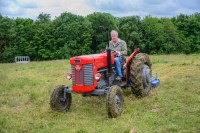Today, the Glorious Twelfth, is the one day of the year most anticipated by game shooters – the start of the grouse season. But, as the first grouse make their way to restaurants and butchers across the country, a battle is being fought on the moors.
The entire sport of grouse shooting is under attack because there are only three breeding pairs of hen harriers left in England – birds that the RSPB argue are endangered due to the actions of those with a vested interest in protecting red grouse from predators. A campaign to ban grouse shooting – complete with an e-petition to Defra – is being orchestrated by Mark Avery, formerly conservation director of the RSPB. His petition currently has almost 14,000 signatures, as well as the support of the likes of Countryfile’s Chris Packham. For many, this takes them back to the late nineties and the last time such a ban was being put forward. Then, of course, it was fox hunting in the firing line.
The RSPB – to their credit – don’t agree entirely with Avery. As I pointed out last week their current conservation director, Martin Harper, is fully aware of the benefits of shooting and has stated that ‘land over which shooting is carried out does some good things for wildlife’.
The thing is, the economic benefits and the environmental benefits of shooting are inextricably linked. Because shooting brings in money (some £2billion per year) from both domestic and foreign sources, moor owners are able to spend money on conservation and management of their moors. Money, it must be said, that is far greater than that spent by the RSPB. As Matt Ridley wrote in The Times yesterday: ‘More than £50 million is spent on conservation by grouse moor owners every year. That’s roughly twice as much as the Royal Society for the Protection of Birds devotes to its entire conservation efforts.’
There is never any excuse for disturbing hen harriers, and as Charles Clover wrote in the Sunday Times, ‘anyone who cares about our wildlife should register their opposition to the illegal stamping-on of eggs and shooting of these protected birds’. But the lack of hen harriers (which, incidentally, are flourishing in Scotland), is no reason to ban grouse shooting. Healthy and diverse moorland is something that needs human management in order to flourish. The RSPB knows this, hence why they cull a number of birds every year (mostly crows and gulls) to protect breeding birds from predation.
Without the money that shooting brings to the rural economy (and the corresponding 74,000 full time jobs that it supports), there would be no incentive to manage the moors – and there is no way that the money currently spent on conservation by the shooting community could or would be matched by the taxpayer or anyone else. Conservation is a huge part of shooting, and not something that only landowners and gamekeepers care about. Companies such as Purdey also do their part, for example through their annual awards for game and conservation which promote biodiversity and healthy wildlife habitats.
It’s all very well sitting back and expecting nature to look after itself, but allowing nature to ‘rewild’ simply won’t work – or at least not in the ways that the likes of George Monbiot or Mark Avery would hope. Many scientists already argue that the reason there are no harriers on the RSPB moors at Geltsdale in the Lakes is because the charity don’t manage their predators. The red grouse and the hen harrier can both live in relative harmony. But they won’t do it without human help – and without shooting, said human help won’t have the funds.
 Join Richard Purdey and The Spectator to celebrate 200 years of Purdey gun and rifle making in the Long Room of Audley House on Thursday 11 September.
For tickets and further information, click here.
Join Richard Purdey and The Spectator to celebrate 200 years of Purdey gun and rifle making in the Long Room of Audley House on Thursday 11 September.
For tickets and further information, click here.







Comments